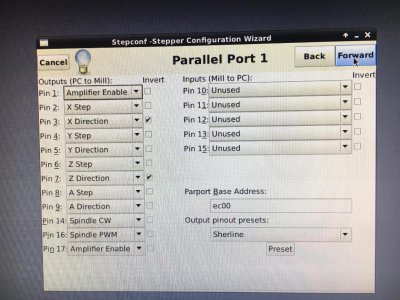- Joined
- May 13, 2019
- Messages
- 1,016
As the title states, I'm trying to configure LinuxCNC using stepconf for a ST-V2 break out board. I'm trying to follow the wiring diagram in the manual for the ST-V BoB.
I think I have the pins setup up properly for the X, Y, and Z-axis for pulse and direction:
X-pulse: 2
X-direction: 3
Y-pulse: 4
Y-direction: 5
Z-pulse: 6
Z-direction: 7
I'm using E-stopin with pin 10. I assume this needs to be set active low.
I'm having trouble on how to set the Enable pin to 14. Which selection in stepconf should I use?
Thanks.
I think I have the pins setup up properly for the X, Y, and Z-axis for pulse and direction:
X-pulse: 2
X-direction: 3
Y-pulse: 4
Y-direction: 5
Z-pulse: 6
Z-direction: 7
I'm using E-stopin with pin 10. I assume this needs to be set active low.
I'm having trouble on how to set the Enable pin to 14. Which selection in stepconf should I use?
Thanks.

